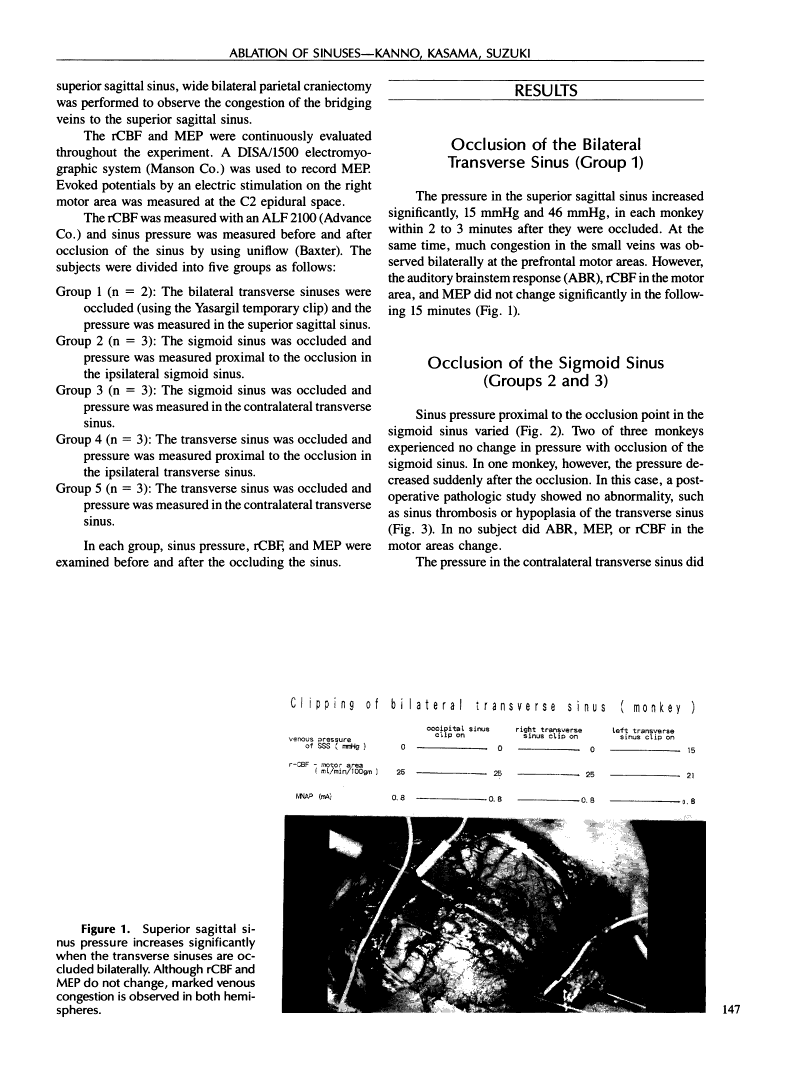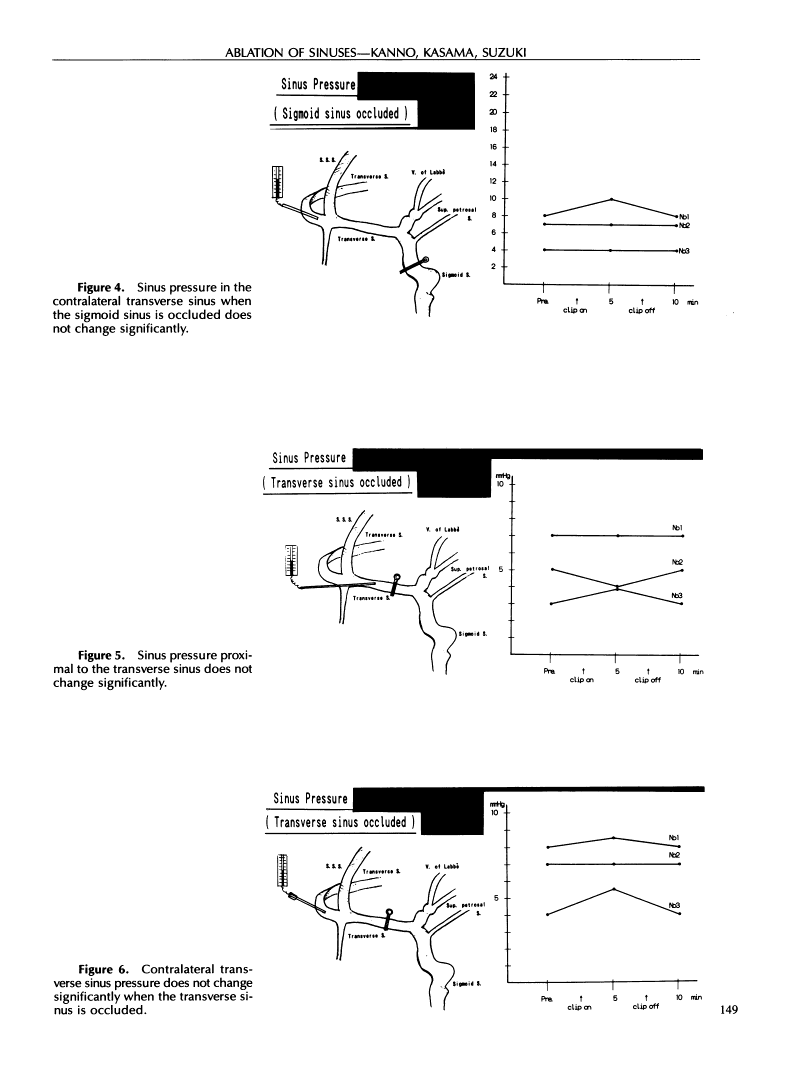Abstract
Free full text

Safety of Ablation of the Sigmoid and Transverse Sinuses
Abstract
If the sigmoid and transverse sinuses could be divided safely, surgeons could broaden their access during skull base surgery without retracting the brain extensively. We undertook this study in monkeys to assess the risk of sacrificing these sinuses. We learned that when bilateral transverse sinuses were occluded, the sinus pressure measured in the superior sagittal sinus increased significantly as blood was purged from sinus venules. Unilateral sacrifice of sigmoid and transverse sinuses, however, did not change proximal sinus pressure in any ipsilateral or contralateral sinus. Furthermore, no change in regional cerebral blood flow or motor evoked potentials was seen in the parietal lobe nor did auditory brainstem response change significantly with sinus ablation. We conclude that, unilaterally, sigmoid and transverse sinuses may be ablated safely because collateral circulation via the vein of Labbé, superior petrosal sinus, petrosal vein, and backflow from the transverse sinus to the contralateral sinus may be established.
Full text
Full text is available as a scanned copy of the original print version. Get a printable copy (PDF file) of the complete article (2.0M), or click on a page image below to browse page by page. Links to PubMed are also available for Selected References.
Images in this article
Click on the image to see a larger version.
Selected References
These references are in PubMed. This may not be the complete list of references from this article.
- Sekhar LN, Goel A. Combined supratentorial and infratentorial approach to large pineal-region meningioma. Surg Neurol. 1992 Mar;37(3):197–201. [Abstract] [Google Scholar]
- Spetzler RF, Daspit CP, Pappas CT. The combined supra- and infratentorial approach for lesions of the petrous and clival regions: experience with 46 cases. J Neurosurg. 1992 Apr;76(4):588–599. [Abstract] [Google Scholar]
- Kanno T, Kasama A, Shoda M, Yamaguchi C, Kato Y. A pitfall in the interhemispheric translamina terminalis approach for the removal of a craniopharyngioma. Significance of preserving draining veins. Part I. Clinical study. Surg Neurol. 1989 Aug;32(2):111–115. [Abstract] [Google Scholar]
- Kasama A, Kanno T. A pitfall in the interhemispheric translamina terminalis approach for the removal of a craniopharyngioma. Significance of preserving draining veins. Part II. Experimental study. Surg Neurol. 1989 Aug;32(2):116–120. [Abstract] [Google Scholar]
Associated Data
Articles from Skull Base Surgery are provided here courtesy of Thieme Medical Publishers
Full text links
Read article at publisher's site: https://doi.org/10.1055/s-2008-1060578
Read article for free, from open access legal sources, via Unpaywall:
https://europepmc.org/articles/pmc1656436?pdf=render
Citations & impact
Impact metrics
Citations of article over time
Article citations
Extent of transverse sinus stenosis does not predict visual outcomes in idiopathic intracranial hypertension.
Eye (Lond), 36(7):1390-1395, 28 Jun 2021
Cited by: 4 articles | PMID: 34183795 | PMCID: PMC9232644
Closure of the sigmoid sinus in lateral skull base surgery.
Acta Otorhinolaryngol Ital, 34(3):184-188, 01 Jun 2014
Cited by: 11 articles | PMID: 24882927 | PMCID: PMC4035837
Review Free full text in Europe PMC
Clinical course of idiopathic intracranial hypertension with transverse sinus stenosis.
Neurology, 80(3):289-295, 26 Dec 2012
Cited by: 80 articles | PMID: 23269597 | PMCID: PMC3589184
Aggressive intracranial dural arteriovenous fistula presenting with cerebrospinal fluid rhinorrhea: case report.
Neurosurgery, 65(6):E1208-9; discussion E1209, 01 Dec 2009
Cited by: 6 articles | PMID: 19934943
Occlusion of the sigmoid sinus after surgery via the presigmoidal-transpetrosal approach.
J Neurosurg, 89(4):575-584, 01 Oct 1998
Cited by: 35 articles | PMID: 9761051
Similar Articles
To arrive at the top five similar articles we use a word-weighted algorithm to compare words from the Title and Abstract of each citation.
Anatomic comparison of veins of Labbé between autopsy, digital subtraction angiography and computed tomographic venography.
Biomed Eng Online, 16(1):84, 26 Jun 2017
Cited by: 5 articles | PMID: 28651592 | PMCID: PMC5485712
Guidelines for the ligation of the sigmoid or transverse sinus during large petroclival meningioma surgery.
Skull Base, 14(1):21-8; discussion 29, 01 Feb 2004
Cited by: 13 articles | PMID: 16145581 | PMCID: PMC1151668
Angiographic assessment of the transverse sinus and vein of labbé to avoid complications in skull base surgery.
Skull Base Surg, 3(4):217-222, 01 Jan 1993
Cited by: 7 articles | PMID: 17170914 | PMCID: PMC1656453
Endovascular Recanalization of Occluded Dural Sinus in Patient with Dural Arteriovenous Fistulas: Case Report and Literature Review.
World Neurosurg, 114:269-273, 27 Mar 2018
Cited by: 4 articles | PMID: 29602009
Review















